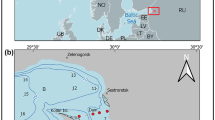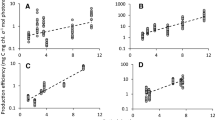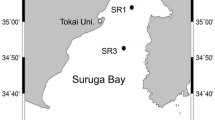Abstract
In order to study the relationships among primary productivity, chlorophyll content and light conditions (underwater quantum irradiance, diffuse attenuation coefficient) in turbid lakes, we performed a series of measurements in three Estonian lakes (Peipsi, Võrtsjärv and Harku) during 2003–2005. We focused on (1) comparison of in situ vertical profiles of planar and scalar quantum irradiances in the water, (2) extremely high values of chlorophyll content and primary production in some turbid lakes and (3) analysis of the formation of the vertical profiles of primary production (shape and the depth of its maximum value) as a function of incident irradiance. The following parameters were measured: (a) primary production at different depths, (b) incident planar quantum irradiance in the region of 400–700 nm, (c) underwater downwelling planar and scalar quantum irradiances at different depths in the same waveband, (d) relative transparency of water (Secchi depth), (e) concentrations of chlorophyll a and (f) spectra of beam attenuation coefficient for unfiltered and filtered water in the wavelength range of 350–700 nm (from water samples). During 36 measurement days (14 in Peipsi, 14 in Võrtsjärv and 8 in Harku), and we collected reliable dataset for 53 measurement series. Our data showed the relative difference between underwater planar and scalar quantum irradiance in a range of about 25–65% implying big differences in primary production models if instead of the preferable scalar quantum irradiance planar irradiance data are used. The results showed a large variation of vertical profiles of primary production in relation to illumination conditions. The depth of maximum primary production depended on water turbidity and incident irradiance, and was located at the water surface in case of low illumination. The relationship between vertically integrated primary production and chlorophyll concentration could be described by a power function with an exponent of 0.64 (R 2 = 0.81).









Similar content being viewed by others
References
Arst, H., A. Erm, M. Hussainov, T. Kutser, S. Mäekivi, A. Reinart & A. Herlevi, 1999. Investigation of Estonian and Finnish lakes by optical measurements in 1992–97. Proceedings of Estonian Academy of Sciences. Biology. Ecology 48: 5–24.
Arst H., A. Erm, A. Reinart, L. Sipelgas & A. Herlevi, 2002. Calculating irradiance penetration into water bodies from the measured beam attenuation coefficient II: application of improved model to different types of lakes. Nordic Hydrology 33(2): 207–226.
Arst, H., 2003. Optical Properties and Remote Sensing of Multicomponental Water Bodies. Springer, Praxis-Publishing, Chichester.
Arst, H., A. Erm, K. Kangro, T. Nõges & P. Nõges, 2006. Comparison of spectral and broad-band models for computing photosynthetically absorbed radiation in turbid waters. Boreal Environmental Research 11: 55–65.
Bannister, T. T., 1974. Production equations in terms of chlorophyll concentration, quantum yield, and upper limit to production. Limnology & Oceanography 19: 1–12.
Berthon, J. -F. & A. Morel, 1992. Validation of spectral light-photosynthesis model and use of the model in conjunction with remotely sensed pigment observations. Limnology & Oceanography 37: 781–796.
Bukata R. P., J. E. Bruton, & J. H. Jerome, 1985. Application of direct measurements of optical parameters to the estimation of lake water quality indicators. Environment Canada, Inland Waters Directorate, National Water Research Institute, Canada Centre for Inland Waters, Burlington, Ontario, Scientific Series 140: 1–35.
Bukata, R. P., J. H. Jerome & J. E. Bruton, 1988. Particulate concentrations in Lake St. Clair as recorded by shipborne multispectral optical monitoring system. Remote Sensing Environment 25: 201–229.
Chekhin, L. P., 1987. Light regime in the water bodies. Karelia Section of the Academy of Sciences USSR, Petrozavodsk: 128 pp. (in Russian).
Dekker, A. G. & S. W. M. Peters, 1993. The use of Thematic Mapper for the analysis of eutrophic lakes: a case study in the Netherlands. International Journal of Remote Sensing 14: 799–821.
Dekker, A. G., R. J. Vos & S. W. M. Peters, 2001. Comparison of remote sensing data, model results and in situ data for total suspended matter (TSM) in the southern Frisian lakes. Science of the Total Environment 268: 197–214.
Erm, A., H. Arst, T. Trei, A. Reinart & M. Hussainov, 2001. Optical and biological properties of Lake Ülemiste, a water reservoir of the city of Tallinn I: water transparency and optically active substances in the water. Lakes and Reservoirs: Research and Management 6: 63–74.
Erm, A., H. Arst, P. Nõges, T. Nõges, A. Reinart & L. Sipelgas, 2002. Temporal variations in bio-optical properties of four North Estonian lakes in 1999–2000. Geophysica 38: 89–111.
Gaarder, T. & H. H. Gran, 1927. Investigation of the production of plankton in Oslo Fjord. Rapport du Conseil Internationale pour l’Exploration de la Mer 42: 1–48.
Gallie, E. A. & P. A. Murtha, 1992. Specific absorption and scattering spectra for suspended minerals and chlorophyll a in Chilko Lake, British Columbia. Remote Sensing Environment 39: 103–118.
Giardino, C., M. Pepe, P. A. Brivio, P. Ghezzi & E. Zilioli, 2001. Detecting chlorophyll, Secchi disk depth and surface temperature in sub-alpine lake using Landsat imagery. Science of the Total Environment 268: 19–29.
Gitelson, A., M. Mayo, Y. C. Yacobi, A. Paparov & T. Berman, 1994. The use of high-spectral-resolution radiometer data for detection of low chlorophyll concentrations in Lake Kinnert. Journal of Plankton Research 16: 993–1002.
Herlevi, A., H. Virta, H. Arst & A. Erm, 1999. Results of light absorption measurements in Finnish and Estonian lakes in summer 1997. Proceedings of Estonian Academy of Sciences. Biology Ecology 48/1: 46–62.
Herlevi, A., 2002. Inherent and apparent optical properties in relation to water quality in Nordic waters. Academic dissertation in Geophysics. Report Series in Geophysics, No 45, University of Helsinki, Finland.
Hilmer, T. & G. C. Bate, 1989. Filter types, filtration and post-filtration treatment in phytoplankton production studies. Journal of Plankton Research 11: 49–63.
Härmä, P., J. Vepsäläinen, T. Hannonen, T. Pyhälahti, J. Kämäri, K. Kallio, K. Eloheimo & S. Koponen, 2001. Detection of water quality using simulated satellite data and semi-empirical algorithms in Finland. Science of the Total Environment 268: 107–121.
Kiefer, D. A. & B. G. Mitchell, 1983. A simple steady state description of phytoplankton growth based on absorption cross section and quantum efficiency. Limnology & Oceanography 28: 770–776.
Kiefer, D. A. & J. J. Cullen, 1990. Phytoplankton growth and light absorption as regulated by light, temperature and nutrients. Polar Research 10: 163–172.
Kirk, J. T. O., 1981. Estimation of the scattering coefficient of natural waters using underwater irradiance measurements. Australian Journal Marine and Freshwater Research 32: 533–539.
Kirk, J. T. O., 1996. Light and Photosynthesis in Aquatic Ecosystems. Cambridge University Press, Cambridge.
Koenings, J. P. & J. A. Edmundson, 1991. Secchi disk and photometer estimates of light regimes in Alaskan lakes: effects of yellow colour and turbidity. Limnology & Oceanography 36: 91–105.
Kyewalyanga, M., T. Platt & S. Sathyendranath, 1992. Ocean primary production calculated by spectral and broad-band models. Marine Ecology Progress Series 85: 171–185.
Lignell, R., 1992. Problems in filtration fractionation of 14C primary productivity samples. Limnology & Oceanography 37: 172–178.
Lorenzen, C. J., 1967. Determination of chlorophyll and phaeopigments; spectrophotometric equations. Limnology & Oceanography 12: 343–346.
Morel, A., 1978. Available, usable and stored radiant energy in relation to marine photosynthesis. Deep-Sea Research 25: 673–688.
Morel, A. & J.-F. Berthon, 1989. Surface pigments, algal biomass, and potential production of the euphotic layer: relationships reinvestigated in view of remote-sensing applications. Limnology & Oceanography 34: 1545–1562.
Nielsen G. A. & A. M. Bresta (eds), 1984. Guidelines for the measurement of phytoplankton primary production. The Baltic Marine Biologists (BMB) Publ. 1: 2nd edn., 23 pp.
Niemi, M., J. Kuparinen, A. Uusi-Rauva & K. Korhonen, 1983. Preparation of algal samples for liquid scintillation counting. Hydrobiologia 106: 149–159.
Nõges, P. & T. Nõges, 1998. Advantages and limitations of optical methods in the estimation of the primary production of lakes. In Pulkkinen, K. (ed.), Report Series in Geophysics 38, Department of Geophysics, University of Helsinki: 59–67.
Nõges, P., 2000. Euphotic holding capacity for optically active substances. Geophysica 36: 169–176.
Patten, B. C. & B. F. Chabot, 1966. Factorial productivity experiments in a shallow estuary: characteristics of response surfaces. Chesapeake Science 7: 117–l36.
Ryther, J. H., 1956. The measurement of primary production. Limnology and Oceanography 1: 72–84.
Peterson, B. J., 1980. Aquatic primary productivity and the 14C–CO2 method: A history of the productivity problem. Annual Review of Ecology and Systematics 11: 359–385.
Schanz, F., 1985. Vertical light attenuation and phytoplankton development in Lake Zürich. Limnology & Oceanography 30: 299–310.
Smith, R. C., B. B. Prezelin, R. R. Bidigare & K. S. Baker, 1989. Bio-optical modeling of photosynthetic production in coastal waters. Limnology & Oceanography 34: 1524–1544.
Sosik, H. M., 1996. Bio-optical modelling of primary production: consequences of variability in quantum yield and specific absorption. Marine Ecology Progress Series 143: 225–238.
Steeman Nielsen, E., 1952. The use of radioactive carbon (14C) for measuring primary production in the sea. Journal du Conseil. Conseil Permanent Internationalpour l’Exploration de la Mer 18: 117–140.
Steemann Nielsen, E., 1962. On the maximum quantity of plankton chlorophyll per surface unit of a lake or the sea. Internationale Revue der gesamten Hydrobiologie und Hydrographie 47: 333–338.
Strickland, J. D. H., 1960. Measuring the production of marine phytoplankton. Fisheries Research Board of Canada Bulletin 122: 1–172.
Strömbeck, N. & D. S. Pierson, 2001. The effects of variability in the inherent optical properties on estimations of chlorophyll a by remote sensing in Swedish freshwaters. Science of the Total Environment 268: 123–137.
Talling, J. F., R. B. Wood, M. V. Prosser & R. M. Baxter, 1973. The upper limit of photosynthetic productivity by phytoplankton: evidence from Ethiopian soda lakes. Freshwater Biology 3: 53–76.
Vinberg, G. G. (ed.), 1961. Primary production of seas and continental waters Minsk, 407 pp. (In Russian, contents in English).
Acknowledgements
The authors are indebted to Estonian Ministry of Education (target funding project 03962480s03 and 0712699s05) and to Estonian Science Foundation (Grant 5594) for financial support to this investigation, and to Ants Erm, Tõnu Feldmann, Medhat Hussainov, Kersti Kangro, Evi Lill and Ilmar Tõnno for their help at field measurements and laboratory analyses.
Author information
Authors and Affiliations
Corresponding author
Additional information
Guest editors: T. Nõges, R. Eckmann, K. Kangur, P. Nõges, A. Reinart, G. Roll, H. Simola & M. Viljanen
European large lakes—Ecosystem changes and their ecological and socioeconomic impacts
Rights and permissions
About this article
Cite this article
Arst, H., Nõges, T., Nõges, P. et al. Relations of phytoplankton in situ primary production, chlorophyll concentration and underwater irradiance in turbid lakes. Hydrobiologia 599, 169–176 (2008). https://doi.org/10.1007/s10750-007-9213-z
Published:
Issue Date:
DOI: https://doi.org/10.1007/s10750-007-9213-z




